Since it’s December and the nights are long and dark, a short quiz on vintage horticultural stuff might pass 5 minutes. Here are ten general questions, the answers and explanations are at the bottom of the page. Each question & answer is like a mini-piece of interesting information.
Questions: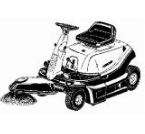
Q1: What is this machine based on?
1. From the 1990s onwards Karcher (of power-washer fame) was selling the Briggs and Stratton powered KMR1000 ride-on sweeper and vacuum which was like a mini road sweeper. Which small, green & yellow ride-on-mower aimed at the domestic market was this Karcher machine based on?
A: MTD Yardman DX70
B: Al-Ko 620 rider
C: John Deere R70
—————-
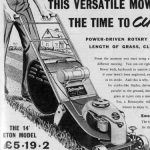
Q2: Was it the Rotoscythe that should be free of purchase tax?
2. Which grass cutting machine caused a debate in Parliament in 1959 because it couldn’t be decided if it should
not be classed as a proper lawnmower and therefore be free of purchase tax at 25% ?
A: Tarpen Grassmaster
B: Shay Rotoscythe (as illustrated, right)
C: Barford Atom mower attachments
—————–
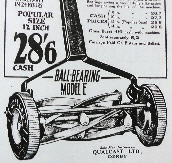
Q3: A million satisfied users by 1938, but how many did Qualcst have by 1951?
3. In 1951 the Qualcast Panther ball-bearing mower was advertised at £7.2.6 complete with grass box and 10 years guarantee. Considering that Qualcast had one million customers by 1938, how many satisfied customers did they claim to have 12 years later in 1951?
A: More than 1,500,000
B: More than 3,000,000
C: More than 4,500,000
——————

Q4: How much was the Nash tractor in 1950?
4. In 1950 the Nash Roller Tractor, by H. R. Nash Ltd, Dorking, was being exhibited at the Dairy Show, Olympia and advertised as a ‘Remarkable Machine’. It was exhibited as a general purpose 3-wheeled tractor designed to cover all types of business and available as a chassis only model or could be had with a flat truck body or tipper body both being £5 extra, but how much was the basic chassis price for this ‘Remarkable Machine’ in 1950?
A: £97
B: £170
C: £227
——————–
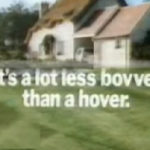
Q5: What was a lot less bovver than a hover in the 1980’s?
5. Flymo used the catchphrase ‘It’s a lot less bovver
with a hover’ to sell their air-cushioned range of mowers. But which of their wealthy and popular rivals counteracted this by using the similar phrase ‘It’s a lot less bovver
than a hover’, image on the right, in their own TV advert?
A: Black & Decker – advertising the RM1 rotary electric mower
B: Spear & Jackson – advertising the Dino 18 rotary electric mower
C: Qualcast – advertising the Concorde cylinder electric mower
———————-
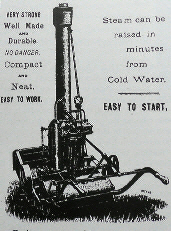
Q6: How many minutes to get the Sumners Patent Steam Lawn mower up to steam?
6. Steam was a popular method of powering machinery in the 1800’s and attempts were made to harness the power for all sorts of factory applications, propulsion and machinery. The Lancashire Steam Motor Co introduced the pedestrian controlled 1.5 ton ‘Sumners Patent Steam Lawn Mower’ in 1893. Time is a valuable resource and the quicker the better, so according to their adverts, approximately how long would it take to raise steam from cold water and get the machine moving?
A: 10 minutes
B: 30 minutes
C: 45 minutes
———————
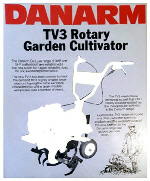
Q7: Which cultivator did Danarm import?
7. Danarm of Stroud, Gloucestershire are well known and respected for their chainsaws. They also had interests in other machines and from the 1970’s Danarm started importing and selling a make of brightly-coloured garden cultivators starting with a 3hp engine model. But what was the cultivator and country of origin?
A: The green and white painted Ferrari cultivators made in Spain
B: The yellow painted Texas cultivators made in Denmark
C: The orange painted Kubota cultivators made in Japan
——————–
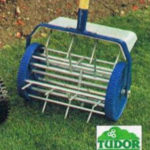
Q8: Did they sell the Tudor lawn aerator?
8. Bob Andrews of Sunningdale, Berkshire, manufactured, retailed and distributed a large range of horticultural equipment through the 1970’s, 80’s and onwards. Some of the popular equipment included the Billy Goat vacuum, Andrew’s portable generator, Cyclone spreader and the Minispike hand-push lawn aerator. But which of the following popular machines, painted blue, did they also sell?
A: Bluebird lawn scarifier
B: Tudor aerator (illustrated, right)
C: Mowrite Auto-Spike attachment for power mowers
——————–
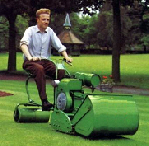
Q9: What mower was driven from Edinburgh to London in 1951?
9. In 1959, five students from De Havilland College in Hatfield rode a lawnmower from Edinburgh Castle to Hyde Park in London, a distance of more than 400 miles. It took over 4 ½ days travelling down the whole of the A1 day and night at 4mph. But which British cylinder mower, as in the pictured example, did they use?
A: Ransomes Matador
B: Royal Enfield Motor Mower
C: Atco Royale
————————-
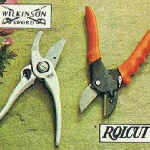
Q10: What model name did Rolcut give to secateurs?
10. Over the years there have been many makers of secateurs. These include such names as Wilkinson Sword, Felco, Greensleeves, and C.K. There was also a large range of secateurs by Rolcut LTD, based in Horsham, West Sussex. They exhibited anvil secateurs which were the first of their kind at the 1927 Chelsea Flower Show. By 1968 there was a vast range of Rolcut secateurs each with a reference number and name including: No.2 Major, No.7 Superlight, and No.18 Ambassador. But which of the following was also a Rolcut secateur name?
A: Snagger
B: Snick
C: Toggle Lopper
————
Answers: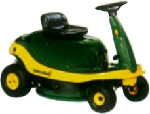
The MTD DX70 is the basis for the Karcher mini road sweeper
1: A: MTD Yardman DX70. Karcher designed their mini road sweeper around the green and yellow beetle-shaped DX70 and apart from the sweeper attachments it looks 95% the same. For clarity, the same DX70 was also sold in an identical shape but clad in a red plastic body shell in some markets.
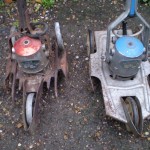
Tarpen Grassmaster
2: A: Tarpen Grassmaster as in the image, right. The debate in Parliament was if the Grassmaster could cut the grass short enough to warrant it being able to cut a lawn. The Grassmaster was subject to purchase tax in 1957, exempt in 1958 and subject to the tax again in 1959 when it was finally decided it was a lawn-mowing machine. This information was sourced from the UK Parliament Hansard archives.
3: B: Qualcast claimed more than than 3,000,000 users in 1951. This was an increase from 1,000,000 ball-bearing mowers in 1938. Therefore approximately 2m ball-bearing mowers were produced in the intervening 12 years – that’s 450 mowers per day.
4: B: The chassis price for the Nash Roller Tractor was £170 in 1950. A 4-wheel version of the tractor was introduced a few years later in 1954. According to reports, the company was sold, with patent rights, to Landmaster Ltd in 1956 who had already been selling the Nash tractor for a couple of years.
5: C: Qualcast used the phrase ‘It’s a lot less bovver than a hover’ in adverts for the Concorde cylinder electric mower. There is a video on Youtube showing their brilliant TV advert with the slogan.
https://youtu.be/4IARuRMLIAU which features Leo McKern (Rumpole of the Bailey).
6: A: It would take an amazingly short 10 minutes to raise steam on the Sumners Patent Steam Lawn Mower made by The Lancashire Steam motor Co. The Sumner name on the mower comes from James Sumner, a blacksmith, who was one of the company founders. Later, The Lancashire Steam Motor Co became Leyland Motors.
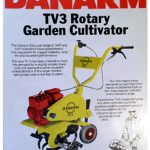
Danarm TV3 Texas Cultivator Advert
7: B: Texas cultivators as in the image and painted yellow, were sold by Danarm in the 1970’s onwards. They were similar to the Merry Tiller design idea and the De-Luxe model was powered by a Briggs and Stratton 3hp engine, later, Kawasaki engines were introduced into the range. Attachments included steel bladed wheels and pneumatic wheels, tool frame with harrows, and end-discs to protect plants at the sides when cultivating.
8: A: Bob Andrews sold the blue-painted power-driven Bluebird lawn scarifier, it retailed for £292 in 1977, But not only did they sell the Bluebird scarifier they apparently also manufactured them too. Bob Andrews also sold the similar Lawn Doctor scarifier. Many of these very well made scarifier machines are still being used today, they can sometimes be found for sale and make a good second-hand purchase.
9: A: Ransomes Matador was rode from Edinburgh to London in 1959. The mower still exists today in preservation and has the original number plate JDX150. There are many photos of the feat on the internet including a recent reunion.
10: All three fantastic names are actually correct, A:Snagger, B: Snick and C: Toggle Lopper being three real names Rolcut gave to models of secateurs. Incidentally Rolcut stopped production of their secateurs to undertake work for the war effort, but by 1949 they were reported to be back to near full production.













